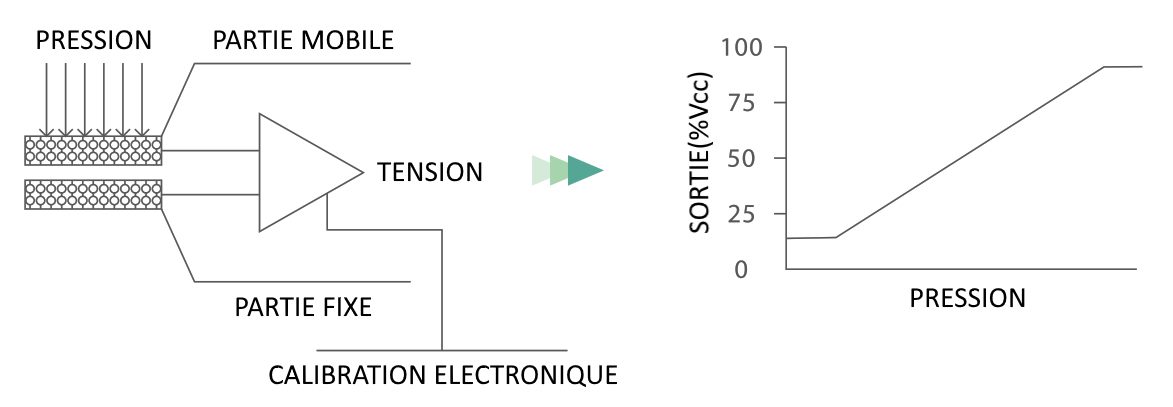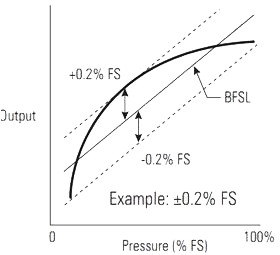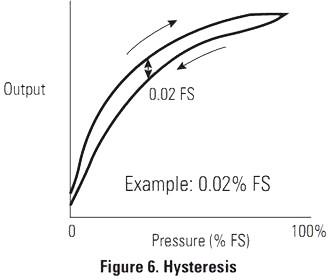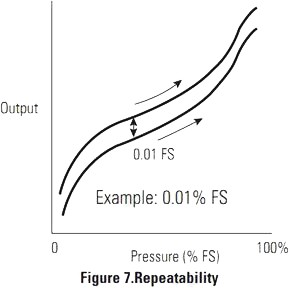What is a capacitive pressure sensor?
The ceramic material capacitive pressure sensor is used for its recognized characteristics of elasticity, corrosion resistance, impact resistance, shock resistance and vibration resistance. Its thermal stability makes it possible to reach a working temperature of -40 to 135 ° C. In addition, it has high measurement accuracy, high stability and the overload capacity can reach up to 100 times the measuring range of other types of sensors. GUILCOR capacitive ceramic pressure sensor combines advanced material and thick film, thin film and low temperature ceramic.
The capacitive element is a parallel plate ceramic sensor. The electrodes in the diaphragm and the substrate are reprinted by an organometallic paste, the two elements are sealed together with a glass paste, this glass paste creates a hermetic effect. When pressure is applied to the surface of the diaphragm (active area), it deforms, resulting in a change in capacitance. The variation in capacity has a proportional relationship to the pressure value. The diaphragm will not be damaged even if it came into contact with the substrate in the event of overload. Once the pressure returns to normal, its performance will not be affected. Its design significantly increases the overload capacity of the sensor.
This is an improved version of the diffusion silicon pressure sensor. The sensor has high temperature and time stability and can come into contact with most media directly. After the ceramic capacitive pressure sensor is assembled, it will be calibrated by ASIC to ensure the output voltage or pulse width modulation accuracy to reach the set standard under a specific pressure. Capacitive ceramic pressure sensor without liquid transmission and without filling liquid. The most important thing is that it will not produce process-related pollution. And because of its high precision and high reliability, having these characteristics, it is widely used in food, medicine, refrigeration, automobile and other industries.
 |
 |
Understanding performance specifications
Sensor accuracy is specified in different ways to help you find the best sensor for a particular application. Specifications include accuracy (static and total error band), linearity, hysteresis, repeatability, calibration and temperature.
Precision
The term accuracy has many different definitions. The most commonly accepted is that it is the sum of errors due to linearity, hysteresis and repeatability at room temperature. Some manufacturers use the square of the sum of the roots of these three sources of error. Presented as a percentage of span (%span written and also %FS is short for full span). The pressure axis span is the total pressure range of a device (for example, for a 0 to 100 psi device, it is 100 psi; for a 200 to 500 psi device, it is 300 psi). The on-axis span of the device corresponds to the full-scale output range (for example, for a 0,5V to 4,5V device, it is 4,0V).
Linearity (or non-linearity)
Linearity is the maximum deviation of the sensor output from a straight line of best fit (BFSL) measured only with increasing pressure. It is typically expressed in ± x% FS. A typical linearity error is shown in Figure 5.

Hysteresis
Hysteresis maximum difference in sensor output at a pressure as that pressure is first approached as pressure increases, then approached as pressure decreases during a full range pressure cycle. It is indicated as less than x% FS. A hysteresis error is shown in Figure 6.

Repeatability
Repeatability is the maximum difference in output when the same pressure is applied, consecutively, under the same conditions and approaching from the same direction. Repeatability is determined by two pressure cycles and is stated to be less than x%FS. The repeatability error is shown in
Figure 7.











